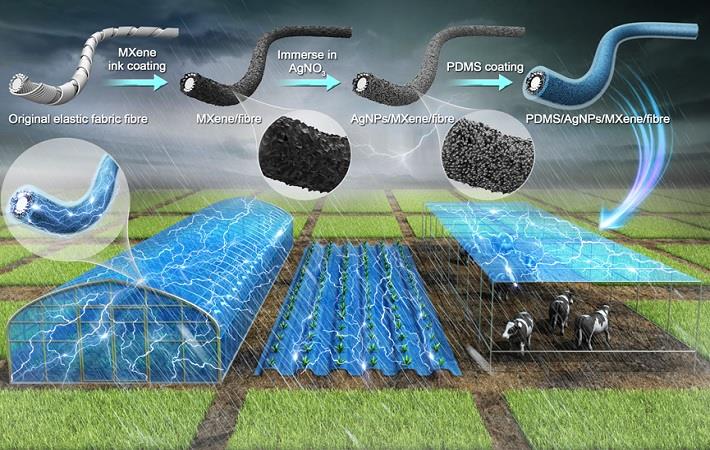Scientists at Zhejiang University have found a new way to convert natural resources in the agriculture environment into electricity. The team applied triboelectric nanogenerators technology to agrotextiles which can harvest raindrop energy and convert it into electricity. The development is important since it is a challenge to supply electricity in farms.
Electricity is indisputably the ‘engine’ of the prosperous development of intelligent agriculture in light of its indispensable role in real-time monitoring. However, it is always a formidable challenge to lay electricity supply lines in farm fields and batteries have finite capacity and pose potential pollution hazards. It is thus essential to develop wireless sensing in intelligent agriculture.Scientists at Zhejiang University have found a new way to convert natural resources in the agriculture environment into electricity. The team applied triboelectric nanogenerators technology to agrotextiles which can harvest raindrop energy and convert it into electricity. The development is important since it is a challenge to supply electricity in farms.#
To solve this problem, the IBE team led by Ping Jianfeng from the College of Biosystems Engineering and Food Science put forward a convenient and effective approach to converting natural resources in the agriculture environment into electricity in an efficient manner. The research team applied the technology of triboelectric nanogenerators (TENG) to agrotextiles which can harvest raindrop energy and convert it into electricity. This research is published in the journal of Nano Energy.
Southern China is often plagued by torrential rain which may result in tremendous losses in agricultural output. Agrotextiles are extensively used in greenhouse facilities in that they can provide shade and protection for crops.
Jianfeng and his team combined these two in an ingenious way by attaching the TENG to the yarn and weaving it into smart agrotextiles which can harvest water flow energy and generate power for intelligent agriculture incessantly.
Experimental data revealed that a 3-centimetre-long string of yarn can generate a voltage of 7.7 V with the continued force of 9.5 N.
“When connected with power-storage devices, these fabricated agrotexitles can not only protect plantation and husbandry so as to improve the quality and quantity of farm produce but also provide a constant supply of electricity for IoT sensors, thereby achieving wireless monitoring and real-time weather forecast for agriculture,” said Jianfeng.
It is because the yarn in agrotextiles has undergone special treatment that raindrop energy can be converted to electricity. The team applied two special coating materials - MXene which is an emerging two-dimensional nanomaterial marked by exceptional metallic electrical conductivity and PDMS which is the most widely used silicon-based organic polymer, and is particularly known for its unusual rheological (or flow) properties.
PDMS is waterproof and able to transfer electrodes with raindrops while the remarkable electrical conductivity of MXene can aid PDMS in capturing electrodes. Thus, they are able to harvest energy from the agricultural environment and provide the impetus for intelligent agriculture, thus rendering ‘wireless real-time sensing’ possible for agricultural information.
“These two materials are biologically compatible. Moreover, they can be easily fabricated at a large scale,” said Jianfeng.
Fibre2Fashion News Desk (SV)
